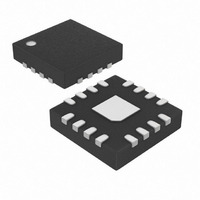MAX9225ETE+ Maxim Integrated Products, MAX9225ETE+ Datasheet - Page 9

MAX9225ETE+
Manufacturer Part Number
MAX9225ETE+
Description
IC SERIALIZER LP 16-TQFN
Manufacturer
Maxim Integrated Products
Datasheet
1.MAX9226ETE.pdf
(15 pages)
Specifications of MAX9225ETE+
Function
Serializer/Deserializer
Data Rate
200Mbps
Input Type
Parallel
Output Type
Parallel
Number Of Inputs
10
Number Of Outputs
1
Voltage - Supply
2.375 V ~ 3.465 V
Operating Temperature
-40°C ~ 85°C
Mounting Type
Surface Mount
Package / Case
16-TQFN Exposed Pad
Lead Free Status / RoHS Status
Lead free / RoHS Compliant
The MAX9225 serializer operates at a 10MHz-to-20MHz
parallel clock frequency, serializing 10 bits of parallel
input data DIN[9:0] in each cycle of the parallel clock.
DIN[9:0] are latched on the rising edge of PCLKIN. The
data and internally generated serial clock are com-
bined and transmitted through SDO+/SDO- using multi-
level LCDS. The MAX9226 deserializer receives the
LCDS signal on SDI+/SDI-. The deserialized data and
recovered parallel clock are available at DOUT[9:0]
and PCLKOUT. Output data is valid on the rising edge
of PCLKOUT.
Bit 0 (DIN[0]) is transmitted first. Boundary bits OH1
and OH2 are used by the MAX9226 deserializer to
identify the word boundary. OH1 is the inverse polarity
of data bit 9 (DIN[9]), and OH2 is the inverse polarity of
OH1. Therefore, at least two level transitions are guar-
anteed in one word. The clock is recovered from the
serial input.
Serial word format:
0
DIN[9:0]
PCLKIN
Functional Diagram (MAX9225)
1
2
MAX9225
3
_______________________________________________________________________________________
LATCH
INPUT
4
Detailed Description
5
CONTROL
TIMING
6
AND
10-Bit, Low-Power, 10MHz-to-20MHz
DLL
Serializer and Deserializer Chipset
7
8
9
OH1 OH2
PWRDN
SDO+
SDO-
The MAX9225/MAX9226 use a proprietary multilevel
LCDS interface. Figure 5 provides a representation of
the data and clock in the multilevel LCDS interface. This
interface offers advantages over other chipsets, such
as requiring only one differential pair as the transmis-
sion medium, the inherently aligned data and clock,
and much smaller current levels than the 4mA typically
found in traditional LVDS interfaces.
The handshaking function of the MAX9225/MAX9226
provides bidirectional communication between the two
devices in case a word boundary error is detected. Prior
to data transmission, the MAX9225 serializer adds
boundary bits (OH) to the end of the latched word.
These boundary bits are the inverse of the last bit of the
latched word. During data transmission, the MAX9226
deserializer continuously monitors the state of the
boundary bits of each word. If a word boundary error is
detected, the serial link is pulled up to V
MAX9226 powers down. The MAX9225 detects the
pullup of the serial link and powers down for 1.0µs. After
1.0µs, the MAX9225 powers up, causing the power-up
of the MAX9226. Then the word boundary is reestab-
lished, and data transfer resumes. The handshaking
function is disabled when PWRDN is pulled low.
SDI+
SDI-
Functional Diagram (MAX9226)
MAX9226
MAX9225/MAX9226 Handshaking
TIMING AND CONTROL
DD
and the
PCLKOUT
DOUT[9:0]
LCDS
9











